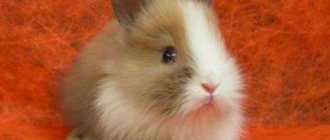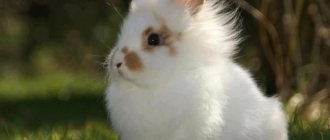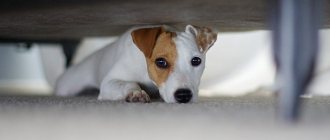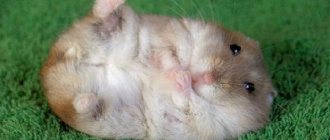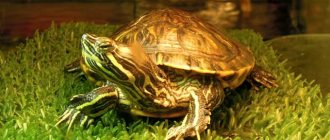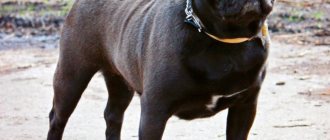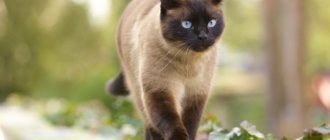Problems with cage placement
Arrangement of housing for a pet requires free space. It is difficult to find even in a private house, not to mention one-room apartments. Taking into account the minimum requirements for the size of a cage for a decorative rabbit (70*30 cm), this is problematic. A separate corner for your pet in the fresh air seems to be the best way out of the situation, but we must not forget about the nuances:
1. The cage is installed only on piles or on another elevation. As a result, the design will appear more cumbersome than it actually is.
2. You will have to take care of an enclosure where the animal can move freely and thereby burn calories. It’s much easier to organize rabbit “fitness” at home.
Don't forget about walks with your pet in the warm season. To do this, choose a remote corner of the city park and take care of such a precaution as a harness.
What breeds of decorative rabbits exist?
No matter how strange it may seem, cute fluffies are very diverse both in character and in appearance (dwarf, giant, long-haired and short-haired, lop-eared and erect-eared). What breeds of decorative rabbits are most often kept at home? These are the Butterfly, the Dutchman, the Rex, the Squirrel, the black-and-fire, the “lop-eared ram.” There are also handsome Angoras, but caring for them and maintaining a home is very difficult due to their long hair.
Therefore, if you are a beginner, then it is best for you to choose the animal that has short fur. This will make it easier for you to care for your baby, because it will take a lot of time to get a fur coat. Yes, the lop-eared rabbit is beautiful, but you need to be very careful with it, because such ears will require special care.
Unsuitable temperature
Keeping decorative rabbits outside is fraught with problems with their well-being. Animals are equally intolerant of heat and frost, exposure to direct sunlight and humidity. Air with a high content of hydrogen sulfide, ammonia or carbon dioxide is also harmful to them. In a word, it is impossible to maintain comfortable conditions for a pet outside the home.
Remember: the suitable temperature is +18–20 °C. In this case, the humidity level should not exceed 50%. Since the regulation of the animal's heat exchange is carried out through the veins in the ears, it will not be superfluous to help on your part. In the summer, blot your rabbit's ears with a cloth soaked in cool water. As a last resort, you can cover the cage with a damp towel or “equip” it with a plastic bottle with ice, after wrapping it in a cloth.
Living with other animals and need for lighting
Some farmers move their rabbit cages to barns or other farm buildings during the winter. It is worth remembering that there should be no other animals in them.
Noise is a big stress for rabbits, they can get sick and die. In addition, in places where other farm animals live, there is always a lot of toxic ammonia fumes. In such conditions, all the eared ones can die in one night.
If pets live alone in the barn, it is necessary to provide them with adequate lighting. It is desirable that the light be natural and they receive ultraviolet light. The area of windows in the room must be at least 10% of the floor area.
However, if there is not enough lighting, rabbits do well in winter under artificial lighting. These animals need 8 to 10 hours of daylight, but no more than 16 hours. Intensity – 30-40 lux.
If the winter keeping of rabbits coincides with a period of intensive fattening, the illumination can be reduced to 10 lux. On large farms, artificial lighting is turned on from 6.00 to 21.00.
Ectoparasites
The absence of a threat from ectoparasites: mosquitoes, fleas, ticks, etc., also speaks in favor of keeping decorative rabbits at home. On the street, the chance of getting uninvited guests increases. Fleas that carry diseases are especially dangerous for fluffies, in particular myxomatosis, accompanied by the formation of tumors and conjunctivitis.
As a preventive measure, you should regularly inspect your rabbit's fur (especially after a walk). Careful animal care is the best preventative measure. If you are unable to protect your pet from fleas, contact your veterinarian for advice. He will suggest an effective and harmless drug.
Remember: the use of flea collars is strictly not recommended!
Childbirth in winter
In a year, a young rabbit will give birth four times. Provided that you approach this issue responsibly and provide conditions for breeding even in winter and even in outdoor conditions. In addition, winter breeding allows you to avoid compacted litters, when, in pursuit of profit, owners sacrifice the health of their rabbits, allowing them to mate within a week after birth. But only experienced farmers, who are not breeding these animals for the first time, can plan it. It is a known fact that rabbits tolerate cold better than heat. This is also an argument in favor of winter mating.
In preparation for childbirth, the cells are additionally insulated, creating cozy, draft-free, but ventilated queen cells. Sufficient space is important; cramped cages are not conducive to breeding. A mother rabbit may even overwhelm her babies if there is too little space. You also need a lot of light so that the animals do not lose interest in mating. In winter, daylight hours are short, so you will have to think about artificial lighting, at least for the mating period. Another tip: don’t skimp on the straw. It is best to put enough of it so that the mother can make a nest there and settle comfortably.
Canopies are made for protection from the wind. If frosts get stronger and threaten 30 degrees below zero, you can move the queen cells to a barn, for example, where the temperature will be higher than outside.
Dangerous neighborhood
Living in a house with other pets, decorative rabbits are perceived by them as neighbors. The only thing that threatens children is obsessive pursuit by a dog or cat (which must be stopped immediately by the owner). As soon as the rabbit is on the street, the situation will change radically: the animal will become a desirable prey. Even an enclosure will not save the big-eared animal from an ongoing hunt, but in this case the pet will end up not only with scratches or bites, but also with stress.
Another thing is important: domestic rabbits are accustomed to the company of animals. Street fluffies are less susceptible to contact with them. If your pet hears a dog barking unexpectedly or a cat hissing, he can literally die of fear. Needless to say, some wild birds will happily carry a rabbit to its nest as soon as it is in an open enclosure?
However, it also happens differently.
Message from one of the site visitors:
I haven’t had rabbits before, the bunny is 2 years old. Appeared in our country house this spring. Can he live on the street? They could build him some kind of house. We can place him in a cage at home, but then is it worth letting him outside in the spring and winter? We were told this is some kind of decorative breed of rabbit. The bunny weighs 6 kilograms, white male, the hair is not very long and fluffy. He likes the site.
Neighbor's cats tried to hunt him. He defends himself with his front and hind paws and runs away. He let one cat come to him, began to sniff her, she tried to touch him with her paw, lifting it from above, and when our Nyusha tried to sniff her from the sides and from behind, the cat constantly turned her face towards him. The cats have now begun to react to him more calmly; sometimes, of course, they jump out of the grass.
Keeping rabbits in winter
There are three factors that the owner should not forget about: humidity, drafts and temperature changes. Humidity above 70% (and this happens in warm, slushy winters), drafty cages and jumps from frost to puddles can damage the health of pets. Remember that ill-conceived winter conditions lead to colds and weight loss.
On the street
As already mentioned, thirty-degree frosts are not scary for rabbits. This is facilitated, in particular, by good cell insulation.
The free space between the walls of the shed and the cages themselves is best filled with natural thermal insulation: dried leaves, straw, branches or moss. You can also use artificial material, for example, felt, but this is not economically viable and not environmentally friendly. The floor is laid with thick wooden boards to protect against freezing. In the cages, the mesh bottom is covered with a heap of straw. The more there is, the better: rabbits warm the straw with their breath, and the heat lasts for a long time.
Important! If possible, for better thermal insulation, rabbit houses can be raised on wooden poles by 75
-
80 cm above the ground.
The outside of the cages is also insulated, and also sheathed with galvanized iron (sheets, overlapping). This prevents moisture from getting inside the houses when the snow melts or there are prolonged rains. When frosts reach alarming temperatures, you can cover the cages with quilted jackets and other warm things.
The so-called queen cells, that is, the cages in which nursing rabbits and small rabbits are kept, are arranged with special care. Female rabbits breed at temperatures of 20-25 degrees below zero, so for a successful birth they need relative warmth, light and access to fresh air. The cage is insulated with polystyrene foam or agro-canvas, avoiding gaps in the nest box. Thick cardboard or oranite is laid on the floor, and a thick layer of straw is spread on it.
It is best to place cells on the south side of buildings. If you place them in rows, with facades facing each other with a small functional passage, then, for example, you can make a common roof against the wind. It will also be convenient to install lighting.
We recommend reading how to keep rabbits in cages.
Transferring cells indoors
Severe frosts, as well as light frosts, but with high humidity, can make adjustments to the outdoor keeping of furry pets. If the owner sees that insulating rabbit cages and other measures do not save the animals from hypothermia, he can take the cages into a barn or any other unheated but closed room. The walls will reliably protect from the wind and smooth out the effects of frost.
You should not bring animals into the house. Firstly, sudden changes in temperature are even more dangerous for their bodies than cold. Secondly, they tolerate heat worse, and female rabbits may even stop feeding the young.
It is not worth placing rabbits with cattle, since stale air can injure them and even lead to death. Also, avoid noisy barns, as roosters, dogs barking and other noises can frighten rabbits, especially nursing mothers.
Did you know? The longest rabbit ears were included in the book of records straight from the USA - in Wichita in 2003 there lived a rabbit with ears 79 cm long!
Lack of constant control
A decorative rabbit kept at home will never go unnoticed by its owner. For this reason, the chance of detecting symptoms of the disease increases. If your furry moves sluggishly, barely eats, or sneezes frequently, it’s time to sound the alarm!
Rabbits living in a cage on the street cannot boast of such a privilege. The owner simply will not notice changes in the pet’s behavior and will not be able to prevent the disease. Unfortunately, in most cases, this inattention is the cause of death and bewilderment of the owner, who instantly lost his best friend.
Advantages
With the right approach, rabbits can be kept outside all year round. There are many advantages to this method.
- Cold air helps rabbits develop stronger immunity - such hardening benefits them and strengthens the body.
- In winter, the risk of contracting infectious diseases is reduced, because most bacteria die under the influence of low temperatures.
- The financial side of keeping rabbits is also important: if they live outside for a whole year, they will not have to spend additional money on a separate shed.
- To arrange winter cages and queen cells, you will need much less effort and money, the main thing is to be able to insulate your pets’ home with your own hands.
During cold weather, no gardening and field work is carried out in which nitrogen-ammonium fertilizers are used, whose evaporation very often causes the death of animals.
Rabbits can even breed and mate outside in winter, but in this case the new mother and long-eared offspring will need to be taken indoors.
Let's sum it up
Decorative rabbits are only suitable for keeping at home, but even in this case it is necessary to take care of their comfort.
The pet must have:
- cage - the bigger the better (it’s better to take it “for growth”);
- the bowl is quite deep and heavy so that the rabbit does not knock it over;
- drinking bowl - ideally attached to an enclosure or cage;
- tray - with fastening and grid (this way your pet will not get dirty);
- toilet filler - wood, without fragrances;
- house - environmentally friendly materials are preferred.
Additional care items will not hurt:
- salt and chalk stones - for grinding teeth;
- carrying (from 60–70 cm in length) - for easy transportation of the animal;
- leash or harness - useful during walks;
- nail cutter - will help shorten claws;
- toys - optional.
Decorative rabbits are pets with a surprisingly flexible character. Keep your little friend with you, raising and caring for him, and he will thank you with love and good mood!
Winter diet for rabbits
The diet in cold weather should take into account the needs of herbivores for nutrients. Pets spend energy heating their bodies, so high-quality and nutritious food must be used to fatten them. Experts recommend heating food before serving to animals; it is also necessary to follow a feeding schedule, prevent leftover food from freezing, and regularly clean the contents of the feeder.
Compound feed for rabbits
What to feed rabbits in winter? During this period, animals need to increase the content of hay and roughage in their diet. In cold weather, food must contain special additives. The diet should be varied; animals can be fed carrots, beets, Jerusalem artichokes, and branches. These products are closest to food in natural conditions. It is best to prepare mash for animals, consisting of several types of feed. To quickly increase the body weight of a herbivore, you can give him boiled potatoes.
Important! Rabbits must receive branch food. It contains useful microelements and vitamins. Pets, instead of gnawing on the cage, can sharpen their teeth on branches.
In winter, herbivores are fed 6 times a day, since the animals need to replenish the resources spent on heating. It is also necessary to maintain a drinking regime - the animals are given warm, fresh water 2 times a day. In ecologically clean areas, the use of melted snow is allowed. Lack of clean water leads to pets drinking their own urine, which can harm them.
Particular attention is paid to the nutrition of pregnant rabbits. To bear healthy offspring, females must receive vitamin feed and mineral supplements. For these purposes, granular feed is often used. The rabbits' diet should contain boiled potatoes, carrots, and sprouted oats. The same nutritional requirements for lactating females, since adequate nutrition helps increase lactation.
How to warm up a newborn rabbit?
In severe frosts, move newborn babies together with the rabbit to a warm room. If the rabbits are very cold, it is recommended to resort to the following procedure, which helps to quickly warm them up:
- Fill a bucket with warm water (you can use any container).
- Take the baby rabbit carefully by the head and body and slowly lower it into warm water. But do not put your head in the water, as the baby will choke.
- After about 5-10 minutes of bathing, the baby rabbit will begin to move.
- As soon as the baby starts to move, stop the procedure.
- Take a dry cloth and dry your baby well. Try to remove as much moisture as possible.
- Place the baby rabbit in the center of the nest and cover it with down.
Organization of a rabbitry in a greenhouse
By the way, if you have unheated greenhouses on your site that are still idle in winter, the best solution would be to place the rabbit brethren there. Keeping rabbits in a greenhouse in winter has its advantages:
- the greenhouse is warmer and there are no drafts;
- Rabbits will fertilize the soil well over the winter.
After harvesting vegetables, rabbits can be released into the greenhouse until spring.
This option allows you to do without several cells. Build a spacious enclosure inside, digging the mesh into the ground about half a meter - you can’t do less, these animals are excellent at breaking under the fence and escaping into the wild.
